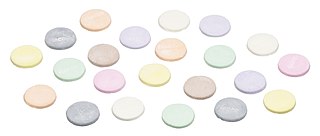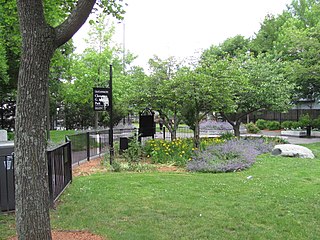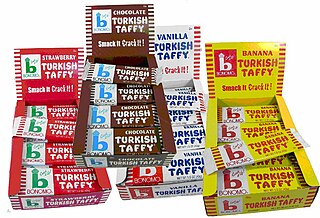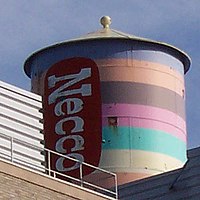
Cambridge is a city in Middlesex County, Massachusetts, United States. It is a suburb in the Greater Boston metropolitan area, located directly across the Charles River from Boston. The city's population as of the 2020 U.S. census was 118,403, making it the most populous city in the county, the fourth-largest in Massachusetts, behind Boston, Worcester, and Springfield, and ninth-most populous in New England. The city was named in honor of the University of Cambridge in Cambridge, England, which was an important center of the Puritan theology that was embraced by the town's founders.

Necco Wafers are a sugar-based candy, sold in rolls of variously-flavored thin disks. First produced in 1847, they became the namesake and core product of the now-defunct New England Confectionery Company (Necco), which operated near Boston, Massachusetts. Production of the candy was suspended in July 2018 when Necco went into bankruptcy, but returned in May 2020 after purchase of the brand and production equipment by the Spangler Candy Company.

Central Square is an area in Cambridge, Massachusetts centered on the junction of Massachusetts Avenue, Prospect Street and Western Avenue. Lafayette Square, formed by the junction of Massachusetts Avenue, Columbia Street, Sidney Street and Main Street, is also considered a part of the Central Square area. Harvard Square is to the northwest along Massachusetts Avenue, Inman Square is to the north along Prospect Street and Kendall Square is to the east along Main Street. The section of Central Square along Massachusetts Avenue between Clinton Street and Main Street is designated the Central Square Historic District, and was added to the National Register of Historic Places in 1990.

Bulk confectionery, pick and mix candy,candy walls, or simply loose candy is a retailing strategy where various types of confectionery are sold together in a large container or in separate bins, allowing customers to select the assortment and quantity they prefer. Typically used in vending machines or confectionery retailers, this method involves dispensing candy by weight or piece count. This method has a global presence, with variations in practice and terminology across regions.

Sweethearts are small heart-shaped sugar candies sold around Valentine's Day. Each heart is printed with a message such as "Be Mine", "Kiss Me", "Call Me", "Let's Get Busy", or "Miss You". Sweethearts were made by the New England Confectionery Company, or Necco, before being purchased by the Spangler Candy Company in 2018. They were also previously made by the Stark Candy Company. Necco manufactured nearly 8 billion Sweethearts per year. Similar products are available from Brach's and other companies. A similar type of candy is sold in the UK under the name Love Hearts; while similar in formulation to Sweethearts, Love Hearts are round, with the heart design and message embossed on their surface.

Necco was an American manufacturer of candy created in 1901 as the New England Confectionery Company through the merger of several small confectionery companies located in the Greater Boston area, with ancestral companies dating back to the 1840s.

Squirrel Nut Caramels and Squirrel Nut Zippers were chewy caramel candy mixed with peanuts.

Sky Bar is an American candy bar introduced by Necco in 1938, discontinued in 2018, and reintroduced in 2019 by the Sky Bar Confectionary Company. Each Sky Bar has four sections, each with a different filling—caramel, vanilla, peanut, and fudge—all covered in milk chocolate.
The Clark Bar is a candy bar consisting of a crispy peanut butter/spun taffy core and coated in milk chocolate. It was introduced in 1917 by David L. Clark and was popular during and after both World Wars. It was the first American "combination" candy bar to achieve nationwide success. Two similar candy bars followed the Clark Bar, the Butterfinger bar (1923) made by the Curtiss Candy Company and the 5th Avenue bar (1936) created by Luden's.

University Park at MIT is a mixed-use urban renewal project in Cambridge, Massachusetts, United States, occupying land near Central Square between the Massachusetts Institute of Technology (MIT) campus and the primarily residential neighborhood of Cambridgeport. It is a joint project of the City of Cambridge, MIT, and Brookfield Asset Management. It is not part of the MIT campus.

The Port, formerly Area 4, is a neighborhood of Cambridge, Massachusetts, roughly between Central Square, Inman Square, and MIT. It is bounded on the south by Massachusetts Avenue, on the west by Prospect Street, on the north by Hampshire Street, and on the east by the Grand Junction Railroad tracks. Area 4 is a densely populated residential neighborhood with about 7,000 residents.

Haviland Thin Mints are a chocolate-covered mint candy produced by Log House Foods of Plymouth, Minnesota. The candy is a mint fondant covered in dark chocolate, similar to the York Peppermint Pattie but smaller, thinner and shorter.

Mary Jane is an old-fashioned peanut butter- and molasses-flavored taffy-type candy.

Turkish Taffy is a "chewy" taffy-like candy bar, which comes in several flavors.

The Shell Oil Company "Spectacular" Sign is a historic advertising sign by the Shell Oil Company located at 187 Magazine Street in Cambridge, Massachusetts.
The Spangler Candy Company is a privately owned confectioner that has been manufacturing and marketing candy for more than a century. Headquartered in Bryan, Ohio, Spangler's products include lollipops, candy canes, and marshmallow circus peanuts. Spangler brand names include Dum-Dums, Bit-O-Honey, Necco Wafers, Sweetheart Candies, Spangler Candy Canes, Spangler Circus Peanuts and Canada Mints. Dum-Dums, the company's most recognized brand, were invented in 1924, and Spangler purchased the rights and equipment in 1953. The small multicolor lollipops are popular as free giveaways. In 2018, Spangler bought various assets and brands from the defunct Necco, retaining the rights to Necco Wafers, Sweethearts conversation hearts, and Canada Mints. In 2020, Spangler bought the rights to Bit-O-Honey from Pearson Candy Company.

The New Center Commercial Historic District is a commercial historic district located on Woodward Avenue between Baltimore Street and Grand Boulevard in Detroit, Michigan. It was listed on the National Register of Historic Places in 2016.

Page & Shaw was one of the largest candy manufacturers in the United States, active from 1888 until about 1960.





















